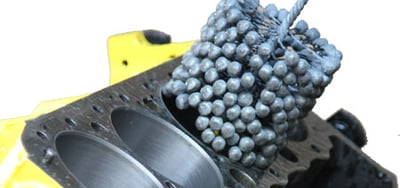 Plateau honing improves the surface finish of cylinder walls by reducing raised areas or peaks to a uniform height and removing cut, torn, and folded metal.
Plateau honing improves the surface finish of cylinder walls by reducing raised areas or peaks to a uniform height and removing cut, torn, and folded metal.
This surface finishing technique also imparts a series of grooves or valleys in a uniform cross-hatch pattern as shown in the image on the right.
Along with improved lubricant control and retention, plateau honing for cylinder walls promotes piston ring seating and sealing. There are many advantages to plateau honing, but here are four things Flex-Hone® users need to know.
BRM Pioneered Plateau Honing
 Brush Research Manufacturing (BRM) pioneered the concept of plateau honing. Today, Flex-Hone® users mount BRM ball hones in handheld power tools or production machinery to impart a uniform, cross-hatch pattern along the length of the entire cylinder. By contrast, honing stones can impart an uneven or unidirectional cross-hatch.
Brush Research Manufacturing (BRM) pioneered the concept of plateau honing. Today, Flex-Hone® users mount BRM ball hones in handheld power tools or production machinery to impart a uniform, cross-hatch pattern along the length of the entire cylinder. By contrast, honing stones can impart an uneven or unidirectional cross-hatch.
The Right Cross-Hatch Pattern Matters
The pistons in an engine cylinder move in a reciprocating or up-and-down motion. If the cylinder walls have a uniform cross-hatch pattern, the upward motion of the piston will spread the engine oil sideways and in both directions for complete lubrication. If the grooves aren’t evenly spaced, however, the piston rings will tend to rotate or surge in the direction of the grooves.
Stroke Rate Drives Cross-Hatch Angle
BRM Flex-Hone® tools don’t require special training or instruction, but users need to understand that the angle at which cross-hatch lines intersect can vary. As a rule, the size of the angle (larger or smaller) is a function of Flex-Hone® stroke rate. In other words, stroke rate drives cross-hatch angle. This table explains.
|
To achieve this type of cross-hatch angle |
Use this type of stroke rate |
|
Smaller |
Lower |
|
Higher |
Larger |
Tool Diameter Affects Cross-Hatching, Too
BRM supplies standard Flex-Hone® tools for cylinders with bores between 4mm and 36”. To achieve the same cross-hatch angle, smaller-diameter Flex-Hone® tools require faster stroke rates than larger-diameter tools. This table provides some recommended stroke rates in inches per minute (IPM).
|
Flex-Hone® tools with these diameters |
Need this stroke rate (recommended) |
To achieve this cross-hatch angle |
|
Small |
250 IPM |
45° |
|
Large |
100 to 120 IPM |
45° |
Learn More. Get the Flex-Hone® Resource Guide
Would you like to learn more about plateau honing? Are you looking for information about Flex-Hone® tool selection and operating parameters? The Flex-Hone® Resource Guide is the ultimate source of information about BRM’s Made in the USA metalworking tools for surface finishing and deburring.









